Countertop washbasin: features of selection and installation
Washbasin, washbasin, sink - plumbing fixtures, the presence of which in the kitchen and bathroom is mandatory. The main component of the device for washing, washing utensils and products is a sink - a container that collects drains and ensures their transportation to the sewer.
When choosing this kind of plumbing, you should focus on the convenience of its use for its intended purpose, as well as ergonomics and style of the bowl. And if the monotonous models of devices are tired, then the overhead sink on the countertop will be an excellent replacement for them.
In our article you will find useful recommendations for choosing a device. We will tell you how to install an overhead plumbing. Based on our advice, you can easily do the job yourself.
The content of the article:
Varieties of overhead sinks
In domestic bathrooms and kitchens, the sink imposed on the countertop is still largely exotic. Similar models are installed on top, and not built into the headset or bedside table.
Often these are more designer and rather expensive variations of washbasins. Conventional utilitarian washbasins suspended on a wall or mounted on a stand are more familiar, cheaper and traditional.
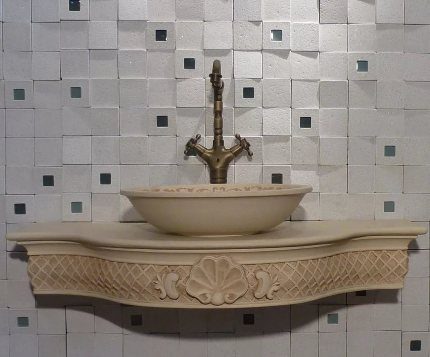
As a countertop under the washbasin, any horizontal surface can be used. No wonder designers so love these sinks.
The tabletop under them can be made of various materials for hi-tech, loft, minimalism, modern, provence and other styles in design. There are practically no restrictions. It is only important that the material of this pedestal is moisture resistant.
False sinks are placed on the countertop or partially immersed in it.Often these are small-sized bowls, which allows them to be installed without problems even in very small domestic bathrooms.
But you can choose a large device, from which water during hygiene procedures and washing dishes will splash out only in extraordinary situations. The absence of the need for a bulky cabinet from below allows the installation of a washbasin above a washing or dishwasher, as well as in a corner or in a niche on the wall.
In shape, a similar bowl in a plumbing store can be found:
- square and rectangular;
- oval and round;
- in the form of a flower, a drop of water, a seashell, etc.
Models of overhead plumbing fixtures can be found both with strict geometric lines in the appearance, and with asymmetric outlines. For this plumbing fixture any shapes, colors and patterns on the bowl are appropriate.
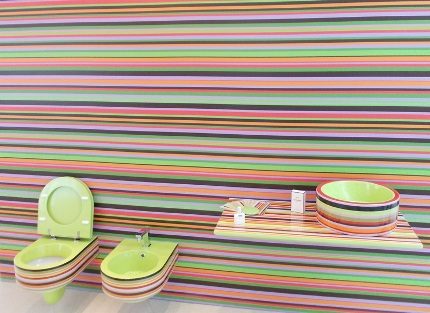
A water tap is installed on the basin of such a washbasin or next to a countertop or wall. Often faucets are sold in one set with the sink, where everything is done in the same style.
If the laid-on washstand is simply placed on the countertop without being buried in it, then only a small hole for the drain pipe is cut out in the tabletop. Otherwise, the hole is already made to the dimensions of the sink.
Choosing a wash bowl by material
The main criterion to which special attention should be paid when choosing countertop sinkis the bowl material. The durability of the washbasin, the simplicity of care for it and the variety of the assortment range in design depend on it.
Option # 1: Tempered Glass
For glass sinks laid on the countertop, a large selection of sizes and shapes is characteristic. Due to the high cost, this is not the most popular option.
However, the glass used to make wash bowls is resistant to shock and household chemicals. It is difficult to break it, scratch or corrode with detergents. This product will last for many years.
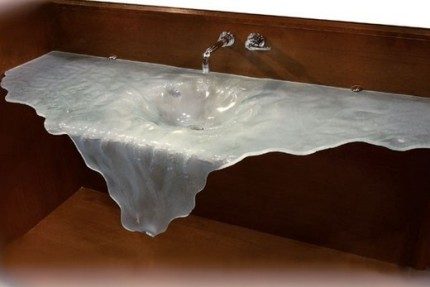
The main problem of glass is drips and stains. Any dirt, toothpaste and soap are immediately visible on the glass surface. Such a sink requires special and constant care. It will have to be washed more often and more thoroughly than a wash basin made of other material, otherwise the whole chic appearance of the bowl will be hidden under dirty stains.
With a variety of species glass plumbing fixtures Introduces an article on the issues of their selection and installation.
Option # 2: natural and artificial stone
Another of the category of expensive, but presentable options:
- marble;
- onyx;
- travertine;
- granite.
Stone bowl bowls are durable, wear-resistant and natural grace. However, if the grinding of their surface was carried out poorly, then due to the porous structure, the stone outside will quickly become dirty. After that, it will be difficult to wash and restore its previous appearance.
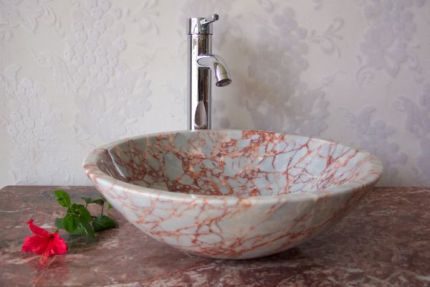
If there is no money for the elegant and expensive naturalness of natural stone, then it can be replaced with a more affordable artificial analogue. It is not only cheaper due to the lower complexity of manufacturing, but also more practical and easier to care for. And outwardly it is almost impossible to distinguish between them.
The main disadvantage of the stone is significant limitations in shape. Usually bowls of stone sinks on the countertop produce round. They are easiest to make on machines.
There are variations in the form of ovals and rectangles with strict smooth lines. But stone washbasins with a different geometry are extremely rare. All such products with curved shapes are made to order manually and are expensive.
Option # 3: acrylic (polymers)
Acrylic overhead sinks belong to the economy segment. They are inexpensive and durable. Countertop for bathroom under them, you can choose less durable and massive than for stone or glass products.
Bowls of acrylic weigh a little, and the shape of the range of models from this material is the widest. It is from it that washbasins are made in the form of a variety of shells and flowers.
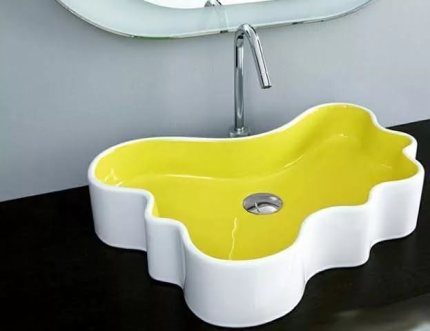
The main disadvantage of overhead acrylic sinks is the high likelihood of scratches. Care must be taken with extreme caution. Cleaning acrylic with abrasive materials is prohibited. Use only liquid or paste detergents when cleaning.
Option # 4: sanitary ware (ceramics)
The best-selling overhead sinks for countertops in bathrooms and kitchens are sanitary ware made of glazed ceramics. This is the most common and familiar material for the manufacture of all types of plumbing fixtures.
The bowls made of it have an ideal surface for smoothness, which is simple and easy to care for. And such ceramics are inexpensive.
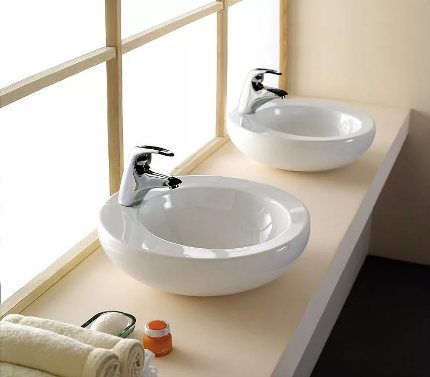
Sanitary ware sinks are quite fragile, from hitting with a heavy or sharp object they simply crack. When installing and using them in the future, additional precautions must be observed.
But as long as the glaze is not damaged, nothing threatens ceramics. Rusty drips and dirty grease stains from the earthenware bowl can be washed off quickly and easily with household detergents, which are usually used at home.
Option # 5: practical metal
Metal overhead sinks are distinguished by an affordable price and high strength. They are somewhat problematic in operation, to maintain the luster and beauty of the metal surface require special care. If they are not cleaned regularly, then such a wash area will look ugly.
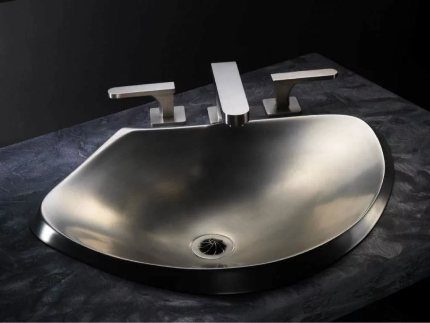
In the manufacture of metal washbasins it is used:
- Copper.
- Brass.
- Stainless steel (stainless steel).
The metal may be coated with glaze. However, in most cases it is left without additional coverage. The disadvantages of such sinks for installation on the countertop include a limited selection of color difficulties in care. But in terms of durability, they will give odds to all other competitors.
Option # 6: natural wood
Yes, sinks are also made of wood. Modern processing technologies, varnishes, stains and polishes make it possible to create a completely moisture-resistant bowl from wood.
Such an element of the interior will certainly attract attention. Such a washbasin overhead looks aesthetically pleasing, impressive and elegant. Growth rings on its surface are the perfect decoration in any bathroom in terms of style and effect.
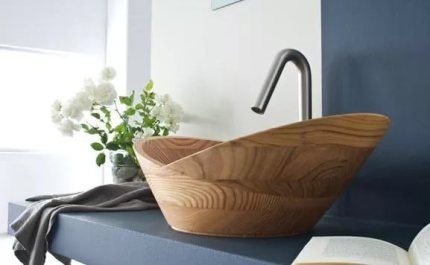
A plumbing fixture made of wood looks great in the bathroom in both classic and eco style. It is stronger than a glass or earthenware wash-hand basin, but inferior in strength to its metal counterpart. In combination with a glass or stone countertop, a wooden sink looks simply stunning.
Plumbing installation
The choice of a sink model installed on or partially in the countertop directly depends on the size of the bathroom (kitchen). If there is practically no free space, then it is better to choose a wash basin with a small bowl. And if there is enough space, then you can turn around in terms of design, choosing a large and deep alternative.
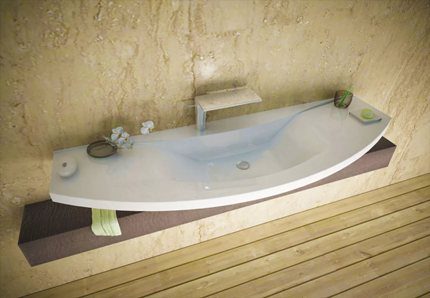
Perfectly sink sizes should be such that when washing, the elbows of the arms apart remain within the bowl. Overhead sinks with a depth of 10-12 cm are compact models. 13–20 cm are medium standard, and 20–30 cm are large washbasins. In width and length, most of these shells fit in the range from 30 to 80 cm.
With the rules for choosing the installation height of the sink, and therefore the mounting of the hanging countertops, next article, the contents of which we advise you to read.
The installation process of the overhead sink is carried out in four stages:
- Cutting holes for draining in the countertop, if the model does not involve a rear or side connection.
- Installation on a wash basin of a drain branch pipe and the mixer (if it is installed on the case of a washstand).
- Placing the sink on the countertop and connecting the siphon.
- Connecting electricity for lighting (if necessary).
If the sink partially deepens into the countertop, then the hole under it should completely coincide in shape and size with the bowl placed inside. The easiest option is a washbasin mounted on a table from above. For him, the hole must be cut small and round with a diameter of only a few centimeters under the drain pipe.
Often, a stencil is attached to a set of built-in sinks for cutting holes in the countertop with your own hands. This greatly simplifies the process, it will be difficult to make mistakes with dimensions. But in any case, it is better to measure and calculate everything several times, and only then start sawing the stove under the washbasin.
Connection of the laid on model to a water supply system and the sewerage should not cause difficulties. This is an ordinary sink, all connections are made using flexible hoses.
The main thing here is that the latter should not be visible under the countertop if everything below remains open in the structure without a pedestal and doors. And all pipes must be connected using sealants.
Before the final installation of the bowl in place of the edges of the countertop, where the cut was carried out, covered with silicone. This will ensure the necessary tightness so that water does not fall down under the wash basin when carelessly spilling out of it.
At the end of the installation, the power supply is connected and everything is checked for leaks. Models of overhead sinks with built-in LED backlighting are still exotic.
However, such new items are found in stores more and more often. Their connection has no special nuances, all wiring diagrams are given in the instructions. It is only necessary to follow what was written by the manufacturer.
Conclusions and useful video on the topic
Video # 1. The installation process of the overhead sink:
Video # 2. Options for overhead sinks in the interior of bathrooms and kitchens:
Video # 3. Nuances of installing a sink in the countertop of a kitchen unit:
With the installation of a laid-on sink, it is quite possible to cope on your own. The most important point in installing it on a countertop is sawing a hole. Everything should be done smoothly and in size.
If there is even the slightest doubt about one's own abilities, then it is better to call a master for this work. Changing the cover of the kitchen headset or the stand in the bathroom under the washbasin will come out much more expensive due to improper cutting.
Please write comments in the block below. Tell us about how to install the overhead plumbing bowl with your own hands. Perhaps you have useful tips that you are ready to share with visitors to the site, or a photo of the process of assembling and fixing the sink?

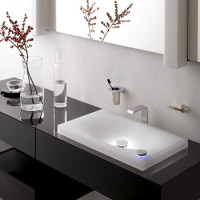 Overhead sink on the countertop in the bathroom: how to choose + installation manual
Overhead sink on the countertop in the bathroom: how to choose + installation manual 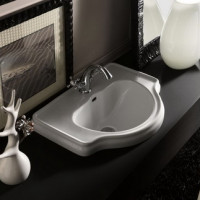 Countertop built-in sink: installation diagrams and analysis of installation features
Countertop built-in sink: installation diagrams and analysis of installation features 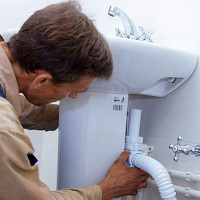 Bathroom sink with pedestal: installation and connection technology
Bathroom sink with pedestal: installation and connection technology 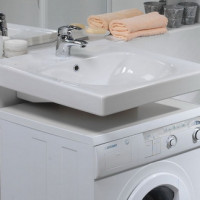 Sink above the washing machine: design features + mounting nuances
Sink above the washing machine: design features + mounting nuances 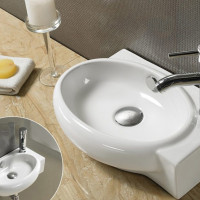 Small bathroom sinks: the nuances of choice and installation + photo selection of ideas
Small bathroom sinks: the nuances of choice and installation + photo selection of ideas 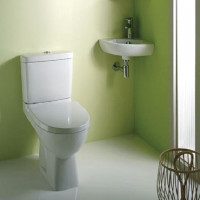 Small washbasins: varieties, photo-selection of options and features of choice
Small washbasins: varieties, photo-selection of options and features of choice  How much does it cost to connect gas to a private house: the price of organizing gas supply
How much does it cost to connect gas to a private house: the price of organizing gas supply  The best washing machines with dryer: model rating and customer tips
The best washing machines with dryer: model rating and customer tips  What is the color temperature of light and the nuances of choosing the temperature of the lamps to suit your needs
What is the color temperature of light and the nuances of choosing the temperature of the lamps to suit your needs  Replacement of a geyser in an apartment: replacement paperwork + basic norms and requirements
Replacement of a geyser in an apartment: replacement paperwork + basic norms and requirements
I always wanted to install an overhead sink in my bathroom so that I could somehow substitute a washing machine, otherwise it doesn’t work out due to the area. And all the time the situation with the siphon stopped, there was nowhere to put a bottle of a sump. The only option in my case is a device where the pipe comes out near the back wall (I found one in online stores), but here it all goes out as usual in the center of the sink, and somehow I did not plan to drill the lid of the washing machine.
There are special exhaust systems for such an installation.
We have a small bathroom. I thought of installing such a sink, because it takes up much less space than a device combined with a cabinet. I chose an acrylic laid on model, its price is much less than, for example, a similar version of stone. I invited the wizard to install, he did everything quickly, and most importantly, qualitatively. Now there is enough space in the bathroom, the sink was installed above the machine, now there is where to turn around.
As my dad says the plumber - any whim for your money. Do you want pipes not to be visible? You are welcome! Want a hinged golden toilet? To your health! Here is the same thing. Yes, it looks beautiful and noble. Yes, from the point of view of diversity, real shikardos. But damn it, the price of pleasure, plus, in some cases, absolute impracticality, very much outweigh.
I do not quite agree with you that such a sink is impractical and causes some inconvenience. Of course, a lot depends on the purpose for which you need this sink. Probably, washing a child or washing her hair is not very convenient, but for the rest it’s quite suitable, if you also choose a normal model, with a more or less deep bowl. Anyway - beauty requires some sacrifice.
Impractical, I would say sinks that cut into the table, and not put on it. For me, the sinks on the countertop are practical. I will explain why:
- in which case something is easy to repair;
- easy to replace;
- There are some difficulties in installation, but it is easy to maintain.
But on the account of the wall mounted toilet, a completely different story is beautiful, but not practical. Here the proverb is acceptable when beauty requires sacrifice. That is, the area of usable space in s \ y decreases (a frame is created for the frame and communication). In this case, it is very important to make an inconspicuous and aesthetic door through which you can then gain access to communications in which case.